Last updated: February 20, 2025
Article
Slavery and Law in 17th Century Massachusetts
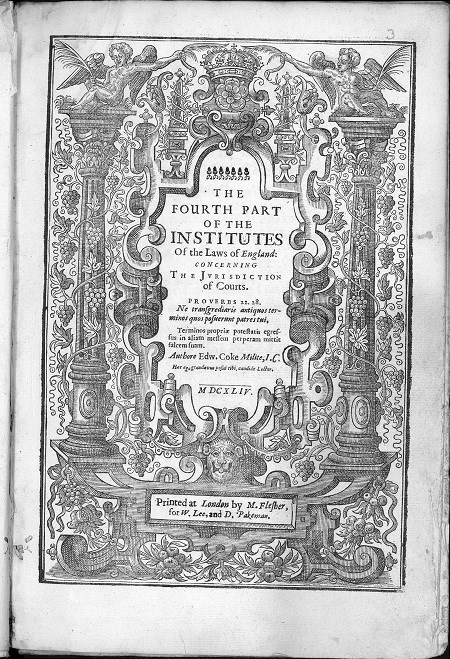
Slavery could not exist without "positive law"—constitutions, statutes, and well-established customs and precedents that legitimated and protected the institution. Without positive law, citizens and judges in colonial and Revolutionary America would have to apply "natural law" to the subject of slavery.[1] Proponents of natural law theory believed there was a set of unchanging, unwritten moral principles that human beings could perceive by divine revelation or reason. They believed that the right to liberty was one of the most important principles of natural law. Seen in that light, slavery was a violation of natural law. How would colonial legislatures and courts deal with slavery?[2]
The first reported English decision on slavery did not occur until 1677 (Butts v. Penny). The King's Bench ruled that infidel or outsider status and sale by a merchant was grounds for enslavement. This justification for slavery had been known to Europeans and Africans for two centuries. After Butts v. Penny, the King’s Bench issued several contradictory rulings on the appropriate legal forms to recover enslaved property and whether "as soon as a negro comes into England, he becomes free."[3]
With no definitive legal ruling, England's colonies drew on earlier customs and precedents to establish slavery into law, when their legislature passed a statute legalizing the institution in 1641.[4]
Early Years of Slavery in Massachusetts
Enslavement in Massachusetts began shortly after the Pequot War of 1637. In July, Governor John Winthrop recorded the price the Pequots paid for resisting White settlers from Massachusetts and Connecticut: "We had now slain and taken, in all, some seven hundred. We sent fifteen of the boys and two women to Bermuda by Mr. [William] Pierce…." Pierce ended up off-course and landed in Providence Isle, a Puritan colony in the Bahamas.[5]
On February 26, 1638, Winthrop noted what Massachusetts received in return for the enslaved Pequots: "Mr. Pierce, in the Salem ship, the Desire, returned from the West Indies after seven months. He had been at Providence [Island], and bought some cotton, and tobacco, and negroes, etc."[6]
Winthrop did not record who purchased the enslaved people, and it is open to debate. Authors John Gorham Palfrey and George H. Moore, writing a year apart, connected Samuel Maverick of Noddles Island [now East Boston] to the origin of slavery in Massachusetts in 1638. Their source was John Josselyn's Account of Two Voyages to New England. Palfrey merely wrote in a footnote: "As early as the year 1638, there were two negro slaves in Massachusetts, held by Mr. Maverick." He did not state that Maverick bought them from the Desire.[7]
Moore connected Maverick's enslaved people to the Desire based on an interpretation of Josselyn's account of a disturbing encounter while visiting Maverick on October 2, 1639. Maverick’s "Negro woman" came to Josselyn's chamber window in hysterics. He could not understand her "Countrey language" but sensed her grief "by her countenance and deportment." Seemingly moved by his belief that she had been a queen before enslavement, Josselyn "repaired to my host to learn of him the cause, and resolved to intreat him on her behalf." He learned that Maverick "was desirous to have a breed of negroes" and when he could not persuade the woman "to company" with his enslaved man, he ordered the man "to go to bed to her." The woman stopped the attempted rape by kicking the man out of bed.[8]
Moore falsely charged Palfrey with writing that Maverick owned two enslaved persons before Winthrop's arrival in 1630, when "the inference is irresistible from all authorities" that he purchased them from the Desire in 1638. Moore cited no authorities but offered his own explanation: Maverick would not have waited ten years "to improve his flock," and ten years of slavery "would have made the negro-queen more familiar with the English language if not more compliant to the brutal customs of slavery."[9]
Three years after their arrival, Massachusetts justified and legalized the enslavement of Africans, Native Americans, and mixed-race people in their Body of Liberties (1641):
91. Bond Slavery: "There shall be never be any bond slavery…amongst us, unless it be lawful captives taken in just wars, and such strangers as willingly sell themselves or are sold to us…."[10]
The Transatlantic Slave Trade
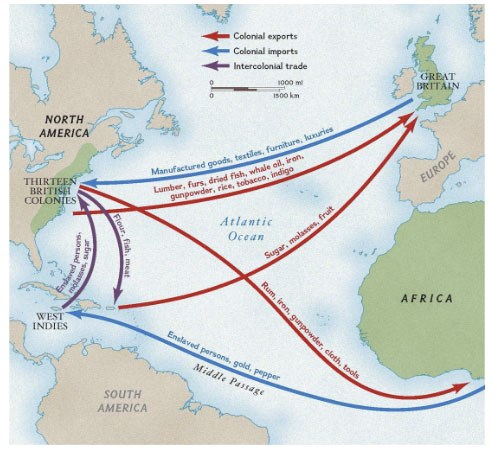
Johnston, "The Making of America," (Washington, D.C.: National Geographic, 2010).
Between 1525-1866, 12.5 million Africans were forcibly transported from their homelands to fill labor demands in North American, South American, and Caribbean colonies (10.7 million survived the "Middle Passage" to the New World.). Europeans, followed by the English, traded guns, copper, iron, textiles, and other manufactured goods in West Africa in exchange for enslaved people, who were then exchanged in the colonies for a "staple product," a raw commodity produced for export, the so-called "Triangular Trade System."[11]
Virginia and Maryland grew tobacco, the most valuable product in Britain’s mainland colonies. In the second half of the 1600s, South Carolina produced rice, and Pennsylvania became the "bread colony," growing corn, wheat, rye, oats, and barley. With the exception of Pennsylvania, enslaved labor produced the most valuable commodities in the British Empire.[12]
Boston merchants initially supplied the West Indies with salted fish to feed enslaved laborers and timber for buildings and fuel in exchange for sugar, molasses, or enslaved people. Soon, Boston dominated trade from communities throughout New England. Abundant timber supplies created a thriving shipbuilding industry, and ultimately the economic success of Massachusetts in the Trans-Atlantic economy came from the "carrying trade." Headed to the West Indies, English and European ports, or Africa, their ships might carry New England produce, livestock, and lumber, Virginia tobacco, or commodities from Atlantic coastal ports.[13]
Enslaved people were a labor source for Massachusetts, imported in small but steady numbers in the first half of the 1600s, but they were also trade commodities.[14] In 1644, Boston merchants began importing enslaved people directly from Africa to the West Indies, where they exchanged them for West Indian sugar and molasses, which would be distilled into rum (a major New England industry) to pay for more enslaved people--the Massachusetts version of "Triangular Trade."[15]
Between 1630-1643, 15-20,000 English men and women migrated to New England. They fueled the economy, trading window glass, chimney backs, pots, kettles, and tools brought from England for milk, corn, livestock, and timber to build houses. Indentured servants provided labor. The outbreak of the English Civil War in 1641 temporarily disrupted this flow of migration, and almost half of the settlers returned to England from 1641-1649.[16]
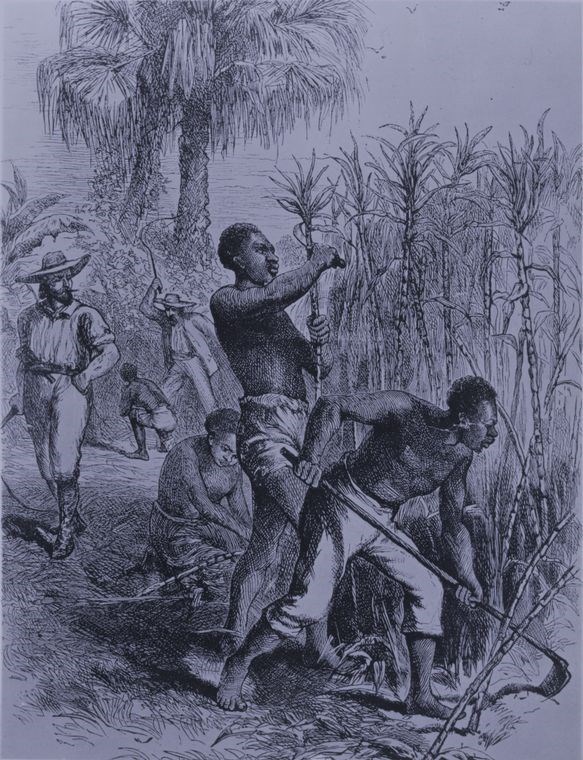
Schomburg Center for Research in Black Culture, Photographs and Prints Division, The New York Public Library
In August 1645, Emmanuel Downing, brother-in-law of Governor Winthrop, suggested a solution to the Massachusetts labor shortage. He encouraged Winthrop to wage war against the Narragansett Indians (a "Just Warre") in order to gain indigenous captives to exchange for enslaved Africans, who he referred to as "Moores," "for I do not see how we can thrive until we get into a stock of slaves sufficient to do all our business." English servants wanted the freedom "to plant for themselves" and "we shall maintain 20 Moores cheaper than one English servant."[17]
Enslaved Africans were not only agricultural workers but also domestic servants and unskilled labor both in rural towns and Boston. In September 1661, Boston selectmen reprimanded Thomas Deane for employing "a Negro" as a cooper "contrary to ye orders of ye Town." They ordered him to stop, subject to a fine of 20 shillings per day. In 1661, they were protecting jobs of White artisans, but by the end of the 17th century, enslaved artisans became a valuable labor source. [18]
The Black enslaved community in Massachusetts was composed of descendants of the first Africans from the West Indies, supplemented by imported Africans via the West Indies and directly from Africa. They shared their enslaved status with Indigenous peoples and other people of color. In Boston, they lived among a community of other unfree people--indentured servants from England, Ireland, and Scotland, and apprentices.[19]
Puritans and Slavery
First encounters of European and English explorers with Africans focused on differences in color, religion, and behavior. In 1554, Captain John Lok, author of "Second Voyage to Guinea," concluded that Africans were "a people of beastly living without a God, law, religion, or commonwealth."[20] Definitions of "Black" in the Oxford English Dictionary century before the 16th century included: "dirty," "sinister," "foul," "wicked," and "malignant." [21]
Racism certainly prepared Massachusetts Puritans to accept African enslavement, but the legal status of enslaved people in the 1600s was not clearly defined. Beyond enumerating who could be enslaved, The Body of Liberties gave no further details about the institution of slavery.[22] Without guidance from positive law, how would Puritan masters govern enslaved people?
They could consult the Bible and custom, defined as "a long-established practice considered as unwritten law," but which Biblical passages and which customs would apply? Colossians 3:22, "Slaves, obey your earthly masters in everything…." and Leviticus 25:46, "You can bequeath them to your children as inherited property and can make them slaves for life..." would create a system of "chattel slavery," in which enslaved people were moveable property to be bought, sold, or bequeathed to heirs.[23]
However, Colossians 4:1, advised: "Masters, provide your slaves with what is right and fair, because you know that you also have a master in heaven." Puritan theology also stressed the slave owner's duty to provide adequate food, housing, and shelter, and to avoid excessive punishment. Some slave owners even considered slavery a form of indentured servitude, with freedom granted after a certain time period for "faithful service" or under the terms of a master’s will.[24]
The Expansion of Slavery in Massachusetts
In the mid-1600s, authorities did not see the small enslaved population as a threat. On May 27, 1652, the Massachusetts General Court (Legislature) ordered "...that all Scotsmen, Negers [Negroes], and Indians... servant to the English, from the age sixteen to sixty" could train with the militia. Four years later, however, in May, 1656, the General Court ordered "that henceforth no negroes or Indians...shall be armed or permitted to train…."[25] Why were authorities becoming fearful of enslaved people?
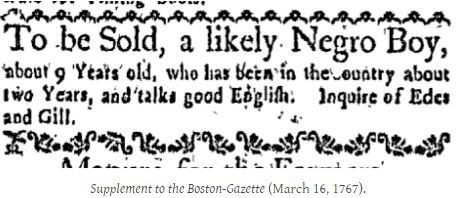
Supplement to the Boston-Gazette, March 16, 1767
Within a decade of importing its first enslaved Africans, Massachusetts had chosen enslaved labor over imported White, indentured servants. England entered the slave trade in 1663, when King Charles II granted a charter to the Royal Adventurers to Africa, but most enslaved Africans went to the Caribbean and Southern colonies. Massachusetts met its needs by importing small numbers of enslaved Africans and by the natural increase of the enslaved population.[26]
The 1641 law said that "strangers" could be enslaved, and by custom, their children were enslaved. What about the next generation? Massachusetts could have adopted statutes from Barbados (1661) and Virginia (1662) that declared children of enslaved women would follow their mother’s legal status, not their father’s, as under English common law. Instead, on October 12, 1670, the General Court simply omitted the word "stranger" from the 1641 statute. Whether it was this 1670 revision or customary practice, Massachusetts colonists (and other New England colonists) accepted slavery as a legitimate institution that could be permanent and hereditary.[27]
After passage of the 1670 revised slavery statute, legislative and court records document steadily negative perceptions of enslaved people. At best, Massachusetts authorities regarded them as "idle, dissolute persons" and at worst, deviant criminals whose behavior and movements must be controlled.
In the 1690s, the General Court passed laws aimed at preventing White people from "harbouring and entertaining... idle, dissolute persons" in taverns or otherwise doing business with them. The laws did not single out enslaved Black people, but variously included them with "Negro servants (free Blacks)," "mulattoes (mixed race)," Indians, apprentices, or "any known, dissolute, lewd, and disorderly person."[28]
In the legal system, however, the Court of Assistants began indicting enslaved Black people for serious, violent crimes shortly after passage of the 1670 statute. On September 13, 1676, "Basto, Negro slave to Robert Cox of Boston" was indicted for raping his master's three-year-old daughter. On September 6, 1681, "Marja Negro servant to Joshua Lamb of Roxbury," and "Jack Negro, servant to Samuel Woolcot" were indicted for arson. All three were found guilty. Basto was hanged, Marja was burned to death, and Jack was hanged, his body taken down, and "burnt to ashes in the fire with Marja Negro."[29]
Enslavement Entering the 1700s
By the end of the 1600s, Massachusetts had come to regard their enslaved population, especially Black people, as disorderly, dissolute, and possibly deviant and dangerous. In 1700, that population numbered 800, as compared to 16,390 in Virginia, but over the course of the 1700s, enslaved Blacks made up an important proportion of Boston's laborers.[30] As slavery became an urban problem, the General Court and Boston Town Meeting reacted much like Southern legislatures: by enacting a multitude of laws to control their enslaved population.
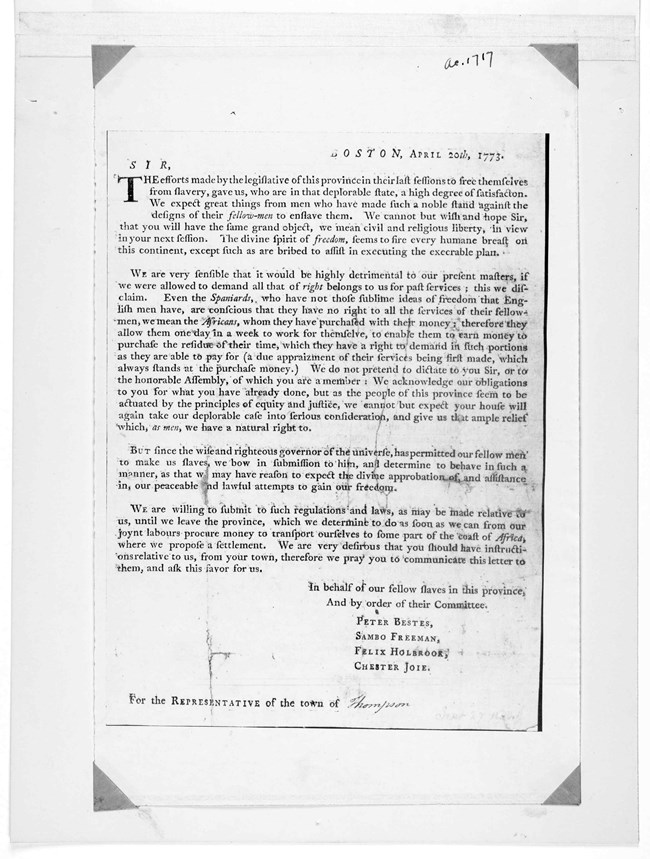
Library of Congress
Despite tightening bonds of racism, Boston's enslaved Black people married, had children, and created a community with enslaved and free Blacks and other people of color. They found coping mechanisms through two institutions they shared with the White community: Christianity and the law. As Christians, they shared a common bond and language with White enslavers that might improve their enslavement. Understanding the law allowed them to seek legal redress for unjust punishment by the courts or against an enslaver who reneged on a promise of freedom.[31]
During the Revolutionary struggle for liberty, Boston's enslaved Blacks used their legal knowledge to petition the General Court for their freedom:
Sir,
The efforts made by the legislative of this province in their last sessions to free themselves from slavery, gave us, who are in that deplorable state, a high degree of satisfaction. We expect great things from men who have made such a noble stand against the designs of their fellow-men to enslave them.[32]
The General Court did not grant their petition.
Contributed by: Jayne Triber, Park Guide
Footnotes:
[1] Definition of positive law: "statutory man-made law, as compared to 'natural law,' which is purportedly based on universally accepted moral principles, 'God's law,' and/or derived from nature and reason. The term 'positive law' was first used by Thomas Hobbes in Leviathan (1651)." Accessed 2020, https://dictionary.law.com/Default.aspx?selected=1552.
[2] Robert Cover, Justice Accused: Antislavery and the Judicial Process (New Haven: Yale University Press, 1975), 1-35, discusses the dilemma of antislavery judges in the mid-19th century who had to decide if positive law outweighed natural law: “It is the story of earnest, well-meaning pillars of legal responsibility and of their collaboration in a system of oppression.” (p. 6) Judges could apply natural law “when no appropriate system of law provided an applicable rule for a given case.” (p.18) First, they would have to examine positive law (constitutions, statutes and “well-settled precedent”) that applied to a given case. Judges in 17th-century British and colonial courts had to use the same process.
[3] William M. Wiecek, The Sources of Antislavery Constitutionalism in America, 1760-1848 (Ithaca: Cornell University Press, 1977), 1-23.
[4] The Body of Liberties, 1641, Article 91, in William Henry Whitmore, The Colonial Laws of Massachusetts Reprinted from the Edition of 1660 With Supplements to 1672 Containing Also the Body of Liberties (Boston: Rockwell and Churchill, 1890), 53. For comparison to slavery laws in other colonies, see Slavery and the Making of America.
[5] Gary B. Nash, Red, White, and Black: The Peoples of North America (Englewood Cliffs, NJ: Prentice-Hall, 1992), 74-86, on Pequot War. Winthrop’s quote in James Kendall Hosmer, ed.,Winthrop’s Journal, 1630-1649, Vol. I (NY: Charles Scribner, 1908), 227-228.
[6] Winthrop’s Journal, p. 260. This is the first recorded evidence of the arrival of enslaved people in Massachusetts. It was, however, a public undertaking, carried out by order of the colonial government of Massachusetts. Merchants or ship’s captains trading with the West Indies could have acquired enslaved people before this; they certainly did after the voyage of Desire. See Jared Ross Hardesty, Black Lives, Native Lands, White Worlds (Amherst and Boston: Bright Leaf Press, an imprint of University of Massachusetts Press, 2019), 17-24.
[7] John Gorham Palfrey, History of New England (Boston: Little, Brown, 1865), Vol. II, p. 30, Footnote 2. He cites his source as John Josselyn’s Account of Two Voyages to New England Made during the year 1638, 1663 by John Josselyn, Gentleman (originally published in London, 1672, 1675. reprinted in Boston: W. Veazie, 1865), 28.
[8] George H. Moore, Notes on the History of Slavery in Massachusetts (N.Y.: D. Appleton and Co., 1866), 7-9, quoting from Josselyn’s Account, 26.
[9] Moore, Notes on the History of Slavery in Massachusetts, 8-9. Maverick was living in Massachusetts in 1624, but Palfrey never said he owned enslaved people before 1638.
[10] Whitmore, Colonial Laws of Massachusetts...Containing Also the Body of Liberties, 53.
[11] Statistics on slave importation to New World from Trans-Atlantic Slave Trade Data Base (https://slavevoyages.org). For a brief overview of Triangular Trade, see Nash, Red, White, and Black, 144-151. For more details, see Jacob M. Price, “The Transatlantic Economy, “ in Jack P. Greene and J.R. Pole, eds., Colonial British America: Essays in the New History of the Early Modern Era (Baltimore: Johns Hopkins Press, 1984), 18-42, and Richard B. Sheridan, “The Domestic Economy,”in Greene and Pole, Colonial British America, 43-85.
[12] The Carribean colonies produced sugar, the most valuable staple product in Britain’s Trans-Atlantic economy. Sheridan, “The Domestic Economy,” 44-47 (Chesapeake), 47-53 (Caribbean), 59-62 (Pennsylvania and other Middle Colonies). Sheridan correctly points out that the “staple economy” thesis can be overstated. When the price of tobacco dropped, the Chesapeake colonies shifted to wheat production. Pennsylvania’s economy also included iron production, shipbuilding, and raw-material and household manufacturing industries.
[13] Hardesty, Black Lives, 17-23; Carl Bridenbaugh, Cities in the Wilderness: Urban Life in America, 1625-1742 (NY: Capricorn Books, 1938), 30-34, 38-39; Sheridan, “The Domestic Economy,” 55-56; James Henretta, The Evolution of American Society, 1700-1815 (Lexington, MA: D.C. Heath and Co., 1973), 78-81.
[14] In 1640, the estimated enslaved population of Massachusetts numbered 150. It increased to 295 in 1650, and 422 in 1660 (including the Maine counties of Massachusetts), in United States Census Bureau, The Statistical History of the United States from Colonial Times to the Present (NY: Basic Books, 1976), 1168
[15] Hardesty, Black Lives, 26-28; “The Slave Trade,” Massachusetts Historical Society (MHS), African Americans and the End of Slavery.
[16] Edmund S. Morgan, The Puritan Dilemma: The Story of John Winthrop (Boston: Little, Brown, 1958), 65-67.
[17] Allyn B. Forbes, ed., The Winthrop Papers (Boston: Massachusetts Historical Society, 1947), 5:38-39.
[18] On Thomas Deane employing a “Negro” cooper, see Report of the Record Commissioners of the City of Boston, 1660-1701, [Boston Town Records], (Boston: Rockwell and Churchill,1881), Vol. 7, p. 5 (September 5, 1661). On the New England economy, see Hardesty, Black Lives, 12-13. For overview of colonial labor choices, see Richard S. Dunn, “Servants and Slaves: The Recruitment and Employment of Labor,” Greene and Pole, Colonial British America, 157-194.
[19] Jared Ross Hardesty, Unfreedom: Slavery and Dependence in Eighteenth-Century Boston (NY: New York University Press, 2018), “Introduction: A World of Unfreedom,” 1-11, 12-15. Hardesty writes about slavery in 18th-century Boston but also discusses its roots in the 17th century. On servants, see Richard S. Dunn, “Servants and Slaves: The Recruitment and Employment of Labor,” in Green and Pole, Colonial British America, 157-164.
[20] “Second Voyage to Guinea” included in Richard Hakluyt, The Principal Navigation Voyages, and Discoveries of the English Nation (London, 1589), quoted in Winthrop Jordan, White Over Black: American Attitudes Toward the Negro: 1550-1812 (Chapel Hill: University of North Carolina Press, 1969), 24.
[21] Morgan, White Over Black, 4-7. Morgan cites the Bible and the works of Shakespeare and John Milton for examples of the English perception of Blackness.
[22] Hardesty, Black Lives,13-17, on “legal ambiguity of slavery.”
[23] Colossians 3:22; Leviticus 25:46; definition of "custom" in Merriam-Webster; definition of “chattel” in Legal Dictionary; Hardesty, Black Lives, pp. 4-5.
[24] Colossians 4:1; Customary rights discussed in Edmund S. Morgan, The Puritan Family: Religion and Domestic Relations in Seventeenth-Century New England (revised edition, NY: Harper and Row, 1966), Chapter IV (“Masters and Servants”); George William Van Cleve, A Slaveholder’s Union: Slavery, Politics, and the Constitution in the Early American Republic (University of Chicago Press, 2010), 24-25). On enslavers interpreting slavery as indentured servitude, see Hardesty, Unfreedom, 15-16.
[25] Records of the Governor and Company of Massachusetts Bay, Nathaniel B. Shurtleff, ed. (Boston: William White, 1854),Vol. III, 1644-1657, 267-268, 397.
[26] Dunn, “Slaves and Servants,” Colonial British America, 157-194 ( 160 on New England); Nash, Red, White, and Black, 150-151.
[27] If they followed English common law, enslaved children fathered by their master would be born free. The revised statute is in Records of the Governor and Company of Massachusetts Bay, Vol. IV, Part 2, 467, under "errartars [errata, or errors.]." Since Massachusetts never passed a law enforcing the revised 1670 statute, masters could still free enslaved people. For different interpretations of the significance of the law, see Eric M. Hanson Plass, “So Succeeded by a Kind Providence: Communities of Color in Eighteenth-Century Boston,” M.A. thesis, University of Massachusetts, Boston, 2014, 28-29; Hardesty, Black Lives, 15-16.
[28] Ch. XXXIV, An Act for the Better Discovery and More Effectual Suppressing of Unlicensed Houses, 1695, pp. 287-288; Ch. LIII, An Act Against Receiving Stolen Goods, 1698, pp. 313-314; Ch. LIV, An Act for the Inspecting and Suppressing Disorders in Licensed Houses, etc., 1698, pp. 414-316, in The Charters and General Laws of the Colony and Province of Massachusetts Bay. Published by the Massachusetts General Court committee of Hon. Nathan Dane, William Prescott, and Joseph Story, Esquires. (Boston: T.B. White, 1814).
[29] John Noble, ed., Records of the Court of Assistants of the Colony of the Massachusetts Bay, Vol. I, 1630-1692 (Boston: Suffolk County, 1901), pp. 74 (Basto), pp. 197-198 (Marja and Jack).
[30] Statistical History of the United States from Colonial Times to the Present, 1168. Gary B. Nash, The Urban Crucible: Social Change, Political Consciousness and the Origins of the American Revolution (Cambridge: Harvard University Press), 1979, writes that between 1685-1699, 1 in 9 Boston families, including merchants and artisans, owned enslaved people, 13-14, and Table 9, 401, showing the rising percentage of enslaved ownership in Boston through the mid-18th century.
[31] Hardesty, Unfreedom, Ch. 5, “Appropriating Institutions,” 136-163; Hanson Plass, “So Succeeded by a Kind Providence: Communities of Color in Eighteenth-Century Boston,” 30-37.
[32] Peter Bestes and Other Slaves Petition for Freedom, April 20, 1773, https://www.loc.gov/resource/rbpe.03701600/?st=text.
